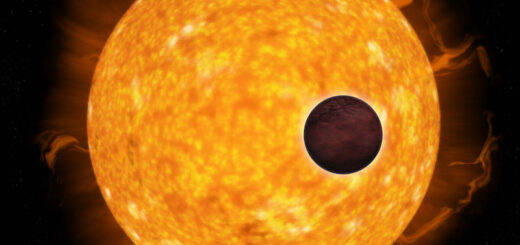Signals From Black Hole Consuming Star Located 300 Million Light Years Away

On Nov. 11, 2014, astronomers picked up signals created by an explosion of electromagnetic energy that occurs when a black hole rips apart a passing star.
Since then, the celestial event has been continuously observed by the best radio telescopes.
Scientists from MIT and Johns Hopkins University have now detected radio signals from the event that match very closely with X-ray emissions produced from the same flare 13 days earlier.
They believe that these radio “echoes,” are not just a coincidence but they rather seem to be evidence of a giant jet of highly energetic particles streaming out from the black hole as stellar material is falling in.
“This is telling us the black hole feeding rate is controlling the strength of the jet it produces,” Dheeraj Pasham, a postdoc in MIT’s Kavli Institute for Astrophysics and Space Research, says.
“A well-fed black hole produces a strong jet, while a malnourished black hole produces a weak jet or no jet at all. This is the first time we’ve seen a jet that’s controlled by a feeding supermassive black hole.”
Scientists have a general understanding for what transpires during a tidal disruption event:
As a star passes close to a black hole, the black hole’s gravitational pull generates tidal forces on the star, similar to the way in which the moon stirs up tides on Earth.
The gravitational forces are so powerful that they can disrupt the star, stretching and flattening it like a pancake and eventually shredding the star to pieces. This entire process generates colossal bursts of energy across the electromagnetic spectrum, which have been observed in the optical, ultraviolet, and X-ray bands, and also occasionally in the radio end of the spectrum.
However, what gives rise to radio emissions during a tidal disruption flare has been up for debate.
“We know that the radio waves are coming from really energetic electrons that are moving in a magnetic field that is a well-established process,” Pasham says. “The debate has been, where are these really energetic electrons coming from?”
Researchers analyzed data recorded from a tidal disruption flare discovered in 2014 and radio data from three telescopes of the event over 180 days and discovered a clear resemblance to patterns they had previously observed in X-ray data from the same event.
“It’s not a coincidence that this is happening,” Pasham says. “Clearly there’s a causal connection between this small region producing X-rays, and this big region producing radio waves.”
The research proposes that the radio waves were caused by a jet of high-energy particles streaming out from the black hole shortly after the black hole began devouring the star.
Thus, they say, the strength of the jet must be controlled by the accretion rate, or the speed at which the black hole is consuming X-ray-emitting stellar debris.
Research is published in the Astrophysical Journal.



 Creators of mankind
Creators of mankind Description of “Tall white aliens”
Description of “Tall white aliens” Where they came from?
Where they came from? About hostile civilizations
About hostile civilizations The war for the Earth
The war for the Earth “Tall white aliens” about eternal life
“Tall white aliens” about eternal life Video: “Nordic aliens”
Video: “Nordic aliens” Aliens
Aliens Alien encounters
Alien encounters The aliens base
The aliens base UFO
UFO Technology UFO
Technology UFO Underground civilization
Underground civilization Ancient alien artifacts
Ancient alien artifacts Military and UFO
Military and UFO Mysteries and hypotheses
Mysteries and hypotheses Scientific facts
Scientific facts


















